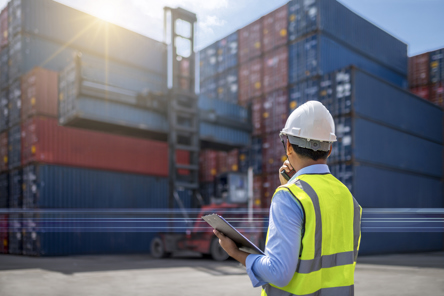No matter what type of organisation you are - whether you’re a growing Ecommerce business or a large enterprise - you’ll need to manage your supply chain effectively. More specifically, you’ll need to store, order and distribute products with an efficiency that leaves your customers satisfied.
One way you can help to make this process smoother is through 3PL (third-party logistics) warehousing. This allows companies to outsource their logistics functions, from storage to fulfilment and distribution.
But what does 3PL warehousing entail, and how can you incorporate it into your end-to-end supply chain solution? To answer this and more, explore SEKO’s expert guide to 3PL warehousing.
WHAT IS A 3PL WAREHOUSE?
A 3PL (third-party logistics) warehouse is a facility owned and operated by a third-party company that specialises in managing the logistics operations of other businesses.
The term 3PL stands for third-party logistics. This refers to logistics services that are outsourced to a company that specialises in handling logistics operations like inventory storage and distribution.
A 3PL warehouse may offer any number of services such as storage, order fulfilment, value added services, shipping, and returns. They often tailor their offerings to their clientele.
So now you know what a 3PL warehouse is, let’s explore how one works in practice.
HOW DOES 3PL WAREHOUSING WORK?
Once your inventory arrives at a 3PL warehouse, the third-party team logs the inbound delivery, organises the products into storage, and tracks inventory levels.
When customer orders come in, the 3PL team handles the entire fulfilment process. This ranges from picking items off the shelves to packaging them and preparing them for shipment.
While it operates much like any modern warehouse, the difference is that your business isn’t involved in the day-to-day logistics. Instead, the 3PL takes responsibility for ensuring that everything runs smoothly.
Let’s explore each aspect of the 3PL warehouse in more detail.
Order Fulfilment
Order fulfilment is at the core of any Ecommerce logistics operation. 3PL warehouses are equipped to handle a wide range of fulfilment needs, from small-scale pick and pack services for Ecommerce businesses to large-scale pallet fulfilment for B2B companies.
Kitting and Repackaging
Kitting involves assembling individual products into a single kit or bundle, creating a new SKU or sellable unit. Repackaging, on the other hand, involves changing the packaging of a product to meet specific requirements or enhance its market appeal.
Ultimately, your 3PL service provider can help you to save on shipping costs and satisfy your end customers faster.
Not every 3PL warehouse offers these services, so be sure to check with potential providers if this is a service your business may need down the line.
Receiving and Inventory Management
3PLs receive inbound freight, put it away in the warehouse locations to enable it to be available for order fulfilment, and handle inventory control & management. This means that they can monitor your inventory levels in real-time and replenish stocks as needed.
Additionally, some 3PL providers specialize in handling specific types of goods, such as temperature-sensitive food products or delicate electronics, that require special care.
Shipping
Almost all 3PL warehouses ship orders to the end customer. Whether you’re using full truckload, less-than-truckload, or last-mile delivery modes, a 3PL can ensure orders are shipped on time.
3PLs can often negotiate better shipping rates due to the large volumes they handle, and they pass these savings on to their clients. Also the 3PL can organise for “will-call” pick up by the clients carrier, allowing the client’s carrier to collect shipments directly from the warehouse.
Returns
Not every 3PL offers returns, but many do. 3PL warehouses that offer returns serve as the home base for items returned by your customers.
These 3PL warehouses print and ship returns labels to customers, process returns, determine what to do with the returned product, and send replacements to your customer where applicable. Some 3PLs even offer returns customer service.
Reporting
3PL warehouses provide their customers with comprehensive reporting to help them track things like inventory, warehouse management KPIs, shipping, and orders.
Reporting offered by 3PLs may even be able to help businesses keep track of metrics such as sales and customer demographics. By utilizing high-level technology often employed by 3PLs, customers may also gain access to improved demand forecasting.
Warehouse Management System Technology (WMS)
In a 3PL warehouse, technology like a warehouse management system (WMS) is one of the most value-added services on offer. A WMS is a type of software that helps track and organise processes in a warehouse to streamline operations and reduce logistics spending.
Often, the WMS is integrated with a client ERP or MRP which can help improve efficiency and reduce costs. There are other benefits, like improved on-time deliveries and the ability to employ just-in-time strategies.
Modern 3PL warehouses also offer their customers access to advanced technology like robotics to help scale operations and improve efficiency.
ADVANTAGES OF USING A 3PL FOR WAREHOUSING
There are many benefits to using a 3PL warehouse for any business involved in Ecommerce logistics. These advantages include:
- Cost savings- 3PLs can help cut costs by reducing infrastructure investments and reducing shipping and packaging costs. They can offer a more efficient workforce, and allow companies to pay only for the services they need at a given time.
- Flexibility and scalability- With the various 3PL options available, businesses can gain flexibility and scalability, adding or reducing services and warehouse space as needed.
- Improved customer service- When logistics operations are smoother, customer experience improves. 3PLs can make packing, returns, and shipments more efficient, giving you the best chance to keep customers satisfied.
- Improved efficiency- Thanks to 3PL technology like WMS, TMS, FMS, and OMS systems and logistics expertise, 3PLs frequently offer more efficient warehousing. As a bonus, logistics staffing is no longer the company’s problem, which is a real sell in a tight labour market.
- Your team can focus on core business functions- By utilizing a 3PL, your company can focus on what it does best.
TYPES OF 3PL WAREHOUSING
Contracted Logistics warehousing
Contracted 3PL warehousing, also known as 4-wall warehousing or dedicated warehousing, allows businesses to contract an entire warehouse and the staff and equipment required to carry out operations.
Multiuser 3PL warehousing
A shared 3PL warehouse space, also known as a multi-user logistics facility, services multiple clients, with inventories for multiple companies housed in one space. Labour may be either shared or dedicated, depending on the 3PL’s model and the customer’s freight volume.
This type of warehousing allows customers to pay only for the space they need on a month-to-month basis. While space and staffing are often shared, the processes in these facilities are typically tailored to each customer’s needs.
This ensures a customisable service that enables businesses to deliver consistent customer experiences across all warehousing operations.
Omnichannel warehousing
Omnichannel 3PL warehousing and omnichannel distribution solutions allow you to service both B2B and B2C customers by offering different types of order fulfilment and shipping options within the same facility.
Ecommerce warehousing
Ecommerce 3PL distribution centres combine advanced technology with traditional warehousing services to fulfil Ecommerce orders, along with handling all other essential warehousing tasks.
HOW MUCH DO 3PL WAREHOUSE SERVICES COST?
The best part about 3PL warehousing costs is that they’re based on the services you need and the level of inventory you need to carry. You contract the logistics services you need and pay only for those services.
Every 3PL has its own pricing model, so it’s important to check over each bid carefully to see what’s included in the base rate and which services you’ll be charged extra for.
Some of the costs associated with 3PL warehousing services include:
- Storage fees
- In-and-out fees (for receiving
- Onboarding/set-up fees (typically a one-time fee)
- Packaging fees (when not included in order fulfillment)
- Order fulfillment charges
- Labeling fees
- Shipping charges
- Returns management charges
- Account management
Storage and order fulfillment fees will make up the majority of 3PL costs. Some factors that might affect the cost of 3PL services include the sensitivity or size of products, the size of your inventory, and the amount of time staff will need to spend handling your product.
As is the case with everything in life, it’s important to remember that you get what you pay for. Sometimes the lowest cost 3PL isn’t the best option if they can’t offer quality service. Be sure to thoroughly vet any 3PL warehousing providers you’re considering.
If you’re considering cashing in on some of the advantages of 3PL warehousing and logistics services, SEKO is an ideal solution. Reach out to our team here.
ABOUT SEKO LOGISTICS
Built on nearly 50 years of logistics expertise, SEKO Logistics is the no-nonsense global end-to-end logistics partner – from factory to consumer.
SEKO delivers sustainable client-first service, expert reliability and tech-driven shipping solutions that turn supply chains into a competitive differentiator. With over 150 offices in more than 40 countries, SEKO helps you move at the speed of commerce. Learn more at www.sekologistics.com.



